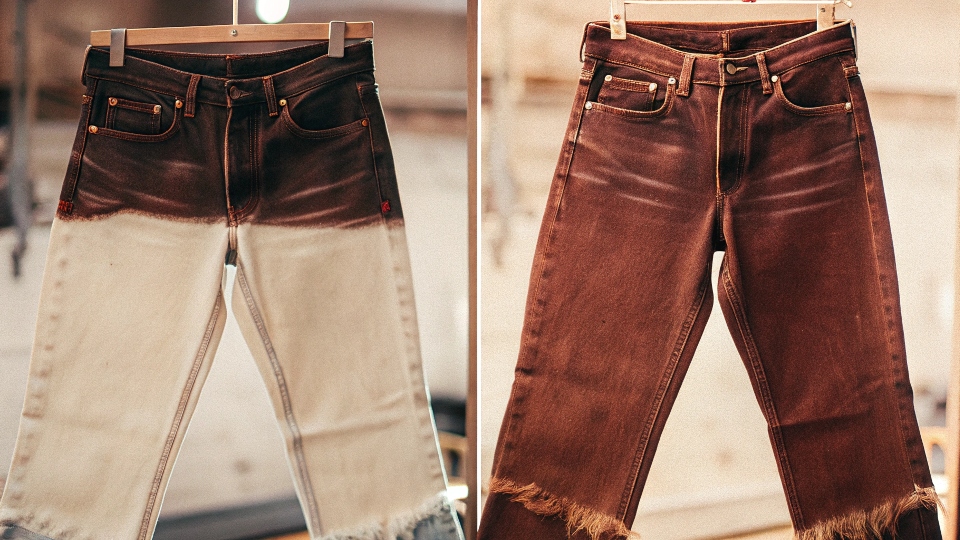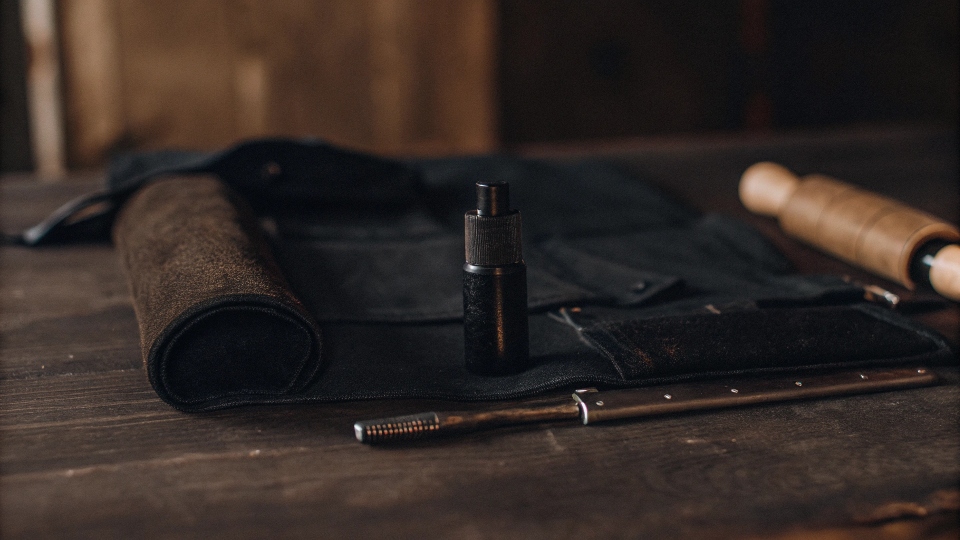Your new jeans are stiff, dark, and lack personality. You crave that soft, faded look of a treasured old pair, but waiting years to achieve it feels impossible. Let me show you how.
To make jeans look vintage, combine three techniques: weaken the fibers with sandpaper1 in high-wear areas, fade the color with hot water washes2 or diluted bleach, and add small frays to pocket edges and hems for an authentic finish.
For over 20 years, my life has been denim. In my factory, DiZNEW, we spend countless hours perfecting the art of the "vintage wash." It's a science and an art form. We use industrial machines and special enzymes3 to replicate years of wear in just a few hours.
A designer I respect, a man named Dean, once told me that the best denim tells a story through its wear and tear. I believe you can create that story yourself, right at home. The professional principles we use can be adapted with simple household tools. Let me share some of my secrets with you.
How do I make my jeans look vintage?
You see perfectly worn-in jeans but can't find them in stores. The new pairs you buy just feel too perfect, too uniform, and lack the character you're looking for.
The secret to a vintage look is a strategic, multi-step process. First, sand high-wear areas like thighs and knees. Next, fade them with hot water. Finally, add small, authentic distress marks like fraying on the hems.
Creating a vintage look is about mimicking the natural aging process. In my experience, you need to address three key areas: the color, the texture, and the wear patterns.
Neglecting one will make the result look unnatural. Here’s how I would approach it, breaking down the factory process into simple home steps.
The Three Pillars of Vintage Style
First, you need to break down the stiff, dark indigo. Think about where your jeans would naturally wear out first.
-
Strategic Fading (Color): The primary goal is to lighten the dark indigo dye in specific places. The sun, friction, and washing do this over time. We will speed that up dramatically.
-
Physical Abrasion (Texture): This is about creating the physical wear patterns. Real vintage jeans have thinning on the thighs, softness at the knees, and characteristic lines around the hips. This is achieved by physically rubbing the fabric.
-
Controlled Distressing (Wear): This is the final touch. It involves adding small tears, holes, and fraying to the edges of pockets and the bottom hem. These small details are what make the jeans look genuinely old.
By tackling all three of these pillars, you create a balanced and authentic vintage look that looks like it was earned over years, not made in an afternoon.
How can I fade my jeans quickly?
You love your jeans' fit, but the dark, uniform color feels boring. You don't have years to wait for them to fade naturally and need a faster method to lighten them up.
For a quick, even fade, wash your jeans inside-out in hot water multiple times. For a more targeted and dramatic fade, lightly spray a 1:10 solution of bleach and water onto the thighs and seat.
Fading is the most important step in creating a vintage look. In my factory, we have specific recipes using enzymes and ozone machines, but the core principle is simply removing indigo dye. Here are two reliable home methods that I recommend.
Method 1: The Natural Wash & Sun Fade
This is the safest method. Turn your jeans inside out and wash them on a long cycle with very hot water. Don't use soap. The heat and agitation will start to release the indigo dye. After washing, you can hang them in direct, bright sunlight for a full day.
The UV rays from the sun are a natural bleaching agent. This process is gentle, so you may need to repeat the wash-and-sun-dry cycle two or three times to see a significant difference. It mimics years of washing and wearing in a few days.
Method 2: The Controlled Chemical Fade
This method is faster but requires care. Always test on a hidden area first, like the inside of a back pocket.
| Desired Fade | Bleach to Water Ratio | Application Method |
|---|---|---|
| Subtle, Sun-kissed | 1 part bleach : 10 parts water | Fine mist spray from a distance. |
| Localized Brightening | 1 part bleach : 5 parts water | Apply with a small paintbrush. |
| Heavy Fading | 1 part bleach : 3 parts water | Sponge onto specific areas. |
After applying the solution, let it sit for about 15-20 minutes, watching it closely. As soon as you reach the desired lightness, immediately wash the jeans in cold water to completely stop the chemical reaction. This method gives you amazing control to create a custom fade.
How to make jeans more worn-in?
Your new jeans are stiff and uncomfortable. You want that soft, broken-in feeling that usually takes months or even years of constant wear to achieve, but you want it now.
To make jeans feel worn-in, you need to physically break down the stiff cotton fibers. Use sandpaper to soften high-friction areas, then wash and dry them with a few clean tennis balls to beat the fabric into submission.
Softness comes from breaking down the starch and short cotton fibers in the denim. When a pair of jeans is new, these fibers are rigid. Our job is to loosen them up, just like your body would over time.
Step 1: Mechanical Softening
This is where you physically replicate the friction of everyday life. Lay your jeans flat and take a sheet of medium-grit sandpaper (around 150-grit).
Gently rub it over the thighs, the seat, and the front and back of the knees. You are not trying to create holes, just a soft, slightly fuzzy texture. You’ll notice the fabric becoming much more pliable in these areas.
Step 2: Creating Natural Creases
For a truly authentic look, you need to add "whiskers4" (the faded lines across the hips) and "honeycombs" (the faded pattern behind the knees). To do this, put the jeans on and scrunch up these areas as they would naturally crease when you sit down.
You can secure the scrunches with rubber bands. Lightly mist these areas with water and let them dry completely while scrunched. This helps set the creases. Then, go over the high points of these new wrinkles very lightly with your sandpaper to make them pop. This subtle detail is a signature of high-end vintage jeans.
How do I distress my own denim?
You want ripped jeans, but the ones in stores have perfectly symmetrical, machine-cut holes that look fake. You want to create your own authentic-looking distress but are afraid of ruining them.
To create natural-looking rips, first thin the area with sandpaper. Then, use a craft knife to make two horizontal cuts, and use tweezers to pull out the vertical blue threads, leaving the horizontal white threads behind.
The biggest mistake people make is grabbing scissors and just cutting a hole. That's not how jeans wear out naturally. Real distress comes from abrasion that wears away the blue warp threads while leaving the white weft threads.
The Art of Controlled Destruction
-
Mark Your Territory: Put the jeans on and use a piece of chalk to mark where you want the distress. The top of the knee is a classic spot that always looks natural.
-
Weaken the Fabric: Take the jeans off and place a block of wood inside the leg behind your mark. Use coarse sandpaper1 or a pumice stone to aggressively rub the area until it is visibly thin and pale. This step is critical and what most people miss. You are creating the foundation for a natural blowout.
-
Perform the Surgery: Use a sharp craft knife5 or box cutter to make two horizontal slits about half an inch apart within the weakened area. Now, grab a pair of tweezers. You will see a grid of blue vertical threads and white horizontal threads. Carefully begin plucking out only the blue vertical threads between your two cuts. It’s tedious, but the result is a perfect, professional-looking fray that exposes the white threads underneath. You can then gently pull at the white threads to make the hole look more organic. This is exactly how the best distressing is done.
Conclusion
Making your jeans look vintage is a rewarding process. With a few simple tools and a little patience, you can turn a boring new pair into a unique piece that feels perfectly, authentically you.
-
Learn the best techniques for using sandpaper to achieve a distressed look on your jeans. ↩ ↩
-
Learn how hot water washes can effectively fade your jeans for a vintage look. ↩
-
Explore the role of enzymes in the denim aging process and how they can enhance your jeans. ↩
-
Discover how to create whiskers for an authentic vintage denim look. ↩
-
Learn the proper way to use a craft knife for creating natural-looking rips in denim. ↩



[^4] solution to create a fade.](https://diznewjeans.com/wp-content/uploads/2025/08/for-a-quick-even-fade-wash-your-jeans-.jpg)







